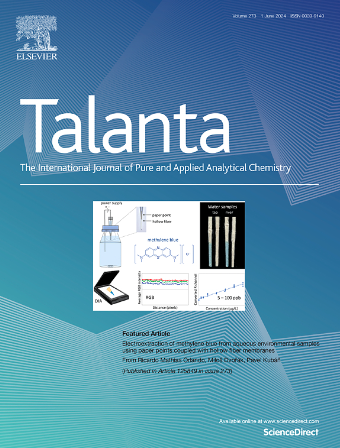以吡啶碳酰肼为配体的碘化亚铜配位聚合物的合成及其在药物检测中的应用
IF 5.6
1区 化学
Q1 CHEMISTRY, ANALYTICAL
引用次数: 0
摘要
通过调节配体(3-吡啶羧酰肼,m-iah)与金属簇(CuI)的配比,制备了两种晶体结构不同、发射波长可调的配位聚合物,分别命名为α-铜(I)碘化物-3-吡啶羧酰肼(α-CuI-m-iah)和β-铜(I)碘化物-3-吡啶羧酰肼(β-CuI-m-iah)。α-CuI-m-iah 被用于荧光检测农药残留物氟美曲林,具有选择性高、抗干扰性强、线性检测范围宽(1 μM-600 μM)等特点。该方法的检测限低(0.49 μM),响应速度快,可有效检测水样中的氟美曲林,回收率在 90.53 % 至 97.13 % 之间。检测机制包括氟曲霉毒素与 α-CuI-m-iah 之间的竞争吸收和荧光共振能量转移(FRET),从而导致荧光强度下降。这项工作不仅介绍了两种具有可调发射行为的配位聚合物,还突出了它们在农药残留检测方面的应用潜力。本文章由计算机程序翻译,如有差异,请以英文原文为准。

Synthesis of cuprous iodide coordination polymers using pyridine carbohydrazide as ligands and their application in drug detection
Two coordination polymers named α-Copper(I) Iodide-3-pyridinecarbohydrazide (α-CuI-m-iah) and β-Copper(I) Iodide-3-pyridinecarbohydrazide (β-CuI-m-iah) with varying crystal structures and tunable emission wavelengths were obtained by adjusting the ligand (3-pyridinecarbohydrazide, m-iah) -to-metal clusters (CuI) ratio during the preparation process. α-CuI-m-iah was employed for the fluorescence detection of pesticide residues flumetralin, which demonstrated high selectivity, strong resistance to interference, and a wide linear detection range (1 μM–600 μM). It also exhibited a low detection limit (0.49 μM) and a fast response time, making it effective for detecting flumetralin in water samples with recovery rates ranging from 90.53 % to 97.13 %. The detection mechanism involved competitive absorption and fluorescence resonance energy transfer (FRET) between flumetralin and α-CuI-m-iah, resulting in a decrease in fluorescence intensity. This work not only introduces two coordination polymers with tunable emission behaviors but also highlights their potential for applications in pesticide residue detection.
求助全文
通过发布文献求助,成功后即可免费获取论文全文。
去求助
来源期刊

Talanta
化学-分析化学
CiteScore
12.30
自引率
4.90%
发文量
861
审稿时长
29 days
期刊介绍:
Talanta provides a forum for the publication of original research papers, short communications, and critical reviews in all branches of pure and applied analytical chemistry. Papers are evaluated based on established guidelines, including the fundamental nature of the study, scientific novelty, substantial improvement or advantage over existing technology or methods, and demonstrated analytical applicability. Original research papers on fundamental studies, and on novel sensor and instrumentation developments, are encouraged. Novel or improved applications in areas such as clinical and biological chemistry, environmental analysis, geochemistry, materials science and engineering, and analytical platforms for omics development are welcome.
Analytical performance of methods should be determined, including interference and matrix effects, and methods should be validated by comparison with a standard method, or analysis of a certified reference material. Simple spiking recoveries may not be sufficient. The developed method should especially comprise information on selectivity, sensitivity, detection limits, accuracy, and reliability. However, applying official validation or robustness studies to a routine method or technique does not necessarily constitute novelty. Proper statistical treatment of the data should be provided. Relevant literature should be cited, including related publications by the authors, and authors should discuss how their proposed methodology compares with previously reported methods.
 求助内容:
求助内容: 应助结果提醒方式:
应助结果提醒方式:


